Dosing & Uses
Dosage Forms & Strengths
injection, lyophilized powder for reconstitution
- 200mg/single-use vial (Gemzar, generics)
- 1g/single-use vial (Gemzar, generics)
solution for injection (generics)
- 200mg/2mL (100mg/mL)
- 200mg/5.26mL (38mg/mL)
- 1g/10mL (100mg/mL)
- 1g/26.3mL (38mg/mL)
- 1.5g/15mL (100mg/mL)
- 2g/20mL (100mg/mL)
- 2g/52.6mL (38mg/mL)
injection, single-dose premixed infusion bag (Infugem)
10mg/mL (contains gemcitabine in 0.9% NaCl) concentration in following sizes:
- 1200mg/120mL
- 1300mg/130mL
- 1400mg/140mL
- 1500mg/150mL
- 1600mg/160mL
- 1700mg/170mL
- 1800mg/180mL
- 1900mg/190mL
- 2000mg/200mL
- 2200mg/220mL
Pancreatic Cancer
Indicated as a single-agent for pancreatic cancer
1000 mg/m² IV infusion over 30 min once weekly x 7 weeks; rest 1 week, THEN
1000 mg/m² IV once weekly for 3 weeks of each 28-day cycle
Various regimens exist including monotherapy and in combination with other chemotherapy agents (eg, erlotinib, paclitaxel protein bound, capecitabine)
Also see Administration
Non-small Cell Lung Cancer
Indicated in combination with cisplatin for non-small cell lung cancer
1000 mg/m² IV infusion over 30 minutes on days 1, 8, and 15 of each 28-day cycle, OR
1250 mg/m² IV infusion over 30 minutes on days 1 and 8 of each 21-day cycle
Administer cisplatin 100 mg/m² IV after gemcitabine on day 1
Also see Administration
Breast Cancer
Indicated in combination with paclitaxel for first-line treatment of metastatic breast cancer after failure of prior anthracycline-containing adjuvant chemotherapy, unless anthracyclines were clinically contraindicated
1250 mg/m² IV infusion over 30 minutes on Days 1 and 8 of each 21-day cycle
With paclitaxel 175 mg/m² on Day 1 as a 3 hr infusion before gemcitabine
Also see Administration
Ovarian Cancer
Indicated in combination with carboplatin for the treatment of advanced ovarian cancer that has relapsed at least 6 months after completion of platinum-based therapy
1000 mg/m² IV infusion over 30 minutes on Days 1 and 8 of each 21-day cycle
With carboplatin AUC 4 on Day 1 after gemcitabine
Also see Administration
Dosage Modifications
Myelosuppression (ovarian cancer)
-
Day 1
- Absolute neurophil count (ANC) ≥1,500 x 10^6/L AND platelet count ≥100,000 x 10^6/L: No dosage adjustment necessary
- ANC <1,500 x 10^6/L OR platelets <100,000 x 10^6/L: Delay treatment
-
Day 8
- ANC≥1,500 x 10^6/L AND platelets ≥100,000 x 10^6/L: No dosage adjustment necessary
- ANC 1,000 to 1499 x 10^6/L OR platelets 75,000 to 99,999 x 10^6/L: 50% of the full dose
- ANC <1,000 x 10^6/L OR platelets <75,000 x 10^6/L: Hold treatment
-
Initial or subsequent occurrences
- ANC <500 x 10^6/L for more than 5 days OR
- ANC <100 x 10^6/L for more than 3 days OR
- Febrile neutropenia OR
- Platelets <25,000 x 10^6/L OR
- Cycle delay of more than 1 week due to toxicity
- If any of the above toxicities occur after the initial dose reduction, permanently reduce dose to 800 mg/m² on Days 1 and 8
Myelosuppression (breast cancer)
-
Day 1
- ANC ≥1,500 x 10^6/L AND platelet count ≥100,000 x 10^6/L: No dosage adjustment necessary
- ANC <1,500 x 10^6/L OR platelets <100,000 x 10^6/L: Hold treatment
-
Day 8
- ANC≥1,200 x 10^6/L AND platelets ≥75,000 x 10^6/L: No dosage adjustment necessary
- ANC 1,000 to 1199 x 10^6/L OR platelets 50,000 to 75,000 x 10^6/L: 75% of the full dose
- ANC 700 to 999 x 10^6/L AND platelets ≥50,000 x 10^6/L: 50% of the full dose
- ANC <700 x 10^6/L OR platelets <50,000 x 10^6/L: Hold treatment
Myelosuppression (non-small cell lung cancer or pancreatic cancer)
- ANC ≥1,000 x 10^6/L AND platelets ≥100,000 x 10^6/L: No dosage adjustment necessary
- ANC 500 to 999 x 10^6/L OR platelets 50,000 to 99,999 x 10^6/L: 75% of the full dose
- ANC <500 x 10^6/L OR platelets ≥50,000 x 10^6/L: Hold treatment
Non-hematologic adverse reactions
-
Permanently discontinue for any of the following:
- Unexplained dyspnea or other evidence of severe pulmonary toxicity
- Hemolytic uremic syndrome
- Severe hepatic toxicity
- Capillary leak syndrome
- Posterior reversible encephalopathy syndrome
- Other severe (Grade 3 or 4) non-hematological toxicity: Withhold or reduce dose by 50% until resolved
- No dose modifications are recommended for alopecia, nausea, or vomiting
Dosing Considerations
Premix bag only: Select the premixed bag that allow for a variance of up to 5% of the BSA-calculated dose (see Administration)
Bladder Cancer (Off-label)
May be considered for muscle-invasive bladder cancer in combination with cisplatin
Cholangiocarcinoma (Orphan)
Orphan designation for treatment of cholangiocarcinoma
Sponsor
- InnoPharmax, Inc; 9F, No. 22, Lane 478, Rueiguang Road; Taipei
Safety and efficacy not established
In clinical studies, patients with various cancers who received gemcitabine as a single agent had a higher rate of Grade 3-4 thrombocytopenia in older patients as compared to younger patients
In a randomized trial in women with ovarian cancer, there was significantly higher Grade 3/4 neutropenia in women 65 years of age or older
Interactions
Interaction Checker
No Results

Contraindicated
Serious - Use Alternative
Significant - Monitor Closely
Minor

Contraindicated (0)
Serious - Use Alternative (13)
- adenovirus types 4 and 7 live, oral
gemcitabine decreases effects of adenovirus types 4 and 7 live, oral by pharmacodynamic antagonism. Avoid or Use Alternate Drug. Immunosuppressives may diminish therapeutic effects of vaccines and increase risk of adverse effects (increased risk of infection). Live-attenuated vaccines should be avoided for at least 3mo after cessation of immunosuppressive therapy.
- axicabtagene ciloleucel
gemcitabine, axicabtagene ciloleucel. Either increases effects of the other by immunosuppressive effects; risk of infection. Avoid or Use Alternate Drug.
- brexucabtagene autoleucel
gemcitabine, brexucabtagene autoleucel. Either increases effects of the other by immunosuppressive effects; risk of infection. Avoid or Use Alternate Drug.
- cedazuridine
cedazuridine will increase the level or effect of gemcitabine by decreasing metabolism. Avoid or Use Alternate Drug. Cedazuridine, a CDA inhibitor, is used with decitabine to increase systemic exposure of decitabine. Use with other drugs metabolized by CDA may increase levels and toxicities of those drugs.
- ciltacabtagene autoleucel
gemcitabine, ciltacabtagene autoleucel. Either increases effects of the other by immunosuppressive effects; risk of infection. Avoid or Use Alternate Drug.
- etrasimod
etrasimod, gemcitabine. Either increases effects of the other by immunosuppressive effects; risk of infection. Avoid or Use Alternate Drug. Risk of additive immune system effects with etrasimod has not been studied in combination with antineoplastic, immune-modulating, or noncorticosteroid immunosuppressive therapies. Avoid coadministration during and in the weeks following administration of etrasimod. .
- idecabtagene vicleucel
gemcitabine, idecabtagene vicleucel. Either increases effects of the other by immunosuppressive effects; risk of infection. Avoid or Use Alternate Drug.
- influenza virus vaccine quadrivalent, adjuvanted
gemcitabine decreases effects of influenza virus vaccine quadrivalent, adjuvanted by pharmacodynamic antagonism. Avoid or Use Alternate Drug. Immunosuppressive drugs may reduce the immune response to influenza vaccine.
- influenza virus vaccine trivalent, adjuvanted
gemcitabine decreases effects of influenza virus vaccine trivalent, adjuvanted by pharmacodynamic antagonism. Avoid or Use Alternate Drug. Immunosuppressive drugs may reduce the immune response to influenza vaccine.
- lisocabtagene maraleucel
gemcitabine, lisocabtagene maraleucel. Either increases effects of the other by immunosuppressive effects; risk of infection. Avoid or Use Alternate Drug.
- palifermin
palifermin increases toxicity of gemcitabine by Other (see comment). Avoid or Use Alternate Drug. Comment: Palifermin should not be administered within 24 hrbefore, during infusion of, or within 24 hr after administration of antineoplastic agents. Coadministration of palifermin within 24 hr of chemotherapy resulted in increased severity and duration of oral mucositis.
- tisagenlecleucel
gemcitabine, tisagenlecleucel. Either increases effects of the other by immunosuppressive effects; risk of infection. Avoid or Use Alternate Drug.
- tofacitinib
gemcitabine, tofacitinib. Either increases toxicity of the other by immunosuppressive effects; risk of infection. Avoid or Use Alternate Drug.
Monitor Closely (26)
- acalabrutinib
acalabrutinib, gemcitabine. Either increases toxicity of the other by pharmacodynamic synergism. Use Caution/Monitor. Coadministration may increase risk of myelosuppressive effects.
- antithrombin III
gemcitabine increases effects of antithrombin III by unspecified interaction mechanism. Use Caution/Monitor. Due to the thrombocytopenic effects of gemcitabine, an additive risk of bleeding may be seen in patients receiving concomitant anticoagulants.
- argatroban
gemcitabine increases effects of argatroban by unspecified interaction mechanism. Use Caution/Monitor. Due to the thrombocytopenic effects of gemcitabine, an additive risk of bleeding may be seen in patients receiving concomitant anticoagulants.
- belatacept
belatacept and gemcitabine both increase immunosuppressive effects; risk of infection. Use Caution/Monitor.
- bivalirudin
gemcitabine increases effects of bivalirudin by unspecified interaction mechanism. Use Caution/Monitor. Due to the thrombocytopenic effects of gemcitabine, an additive risk of bleeding may be seen in patients receiving concomitant anticoagulants.
- cholera vaccine
gemcitabine decreases effects of cholera vaccine by immunosuppressive effects; risk of infection. Modify Therapy/Monitor Closely. Immunosuppressive therapies, including irradiation, antimetabolites, alkylating agents, cytotoxic drugs and corticosteroids (used in greater than physiologic doses), may reduce the immune response to cholera vaccine.
- dalteparin
gemcitabine increases effects of dalteparin by unspecified interaction mechanism. Use Caution/Monitor. Due to the thrombocytopenic effects of gemcitabine, an additive risk of bleeding may be seen in patients receiving concomitant anticoagulants.
- dengue vaccine
gemcitabine decreases effects of dengue vaccine by immunosuppressive effects; risk of infection. Use Caution/Monitor. Immunosuppressive therapies (eg, irradiation, antimetabolites, alkylating agents, cytotoxic drugs, corticosteroids [greater than physiologic doses]) may reduce immune response to dengue vaccine.
- denosumab
gemcitabine, denosumab. Other (see comment). Use Caution/Monitor. Comment: Caution should be taken in patients on concomitant immunosuppressants or with impaired immune systems because of increased risk for serious infections.
- dichlorphenamide
dichlorphenamide and gemcitabine both decrease serum potassium. Use Caution/Monitor.
- enoxaparin
gemcitabine increases effects of enoxaparin by unspecified interaction mechanism. Use Caution/Monitor. Due to the thrombocytopenic effects of gemcitabine, an additive risk of bleeding may be seen in patients receiving concomitant anticoagulants.
- fingolimod
gemcitabine increases effects of fingolimod by immunosuppressive effects; risk of infection. Modify Therapy/Monitor Closely. Concomitant therapy is expected to increase the risk of immunosuppression. Use caution when switching patients from long-acting therapies with immune effects. .
- fondaparinux
gemcitabine increases effects of fondaparinux by unspecified interaction mechanism. Use Caution/Monitor. Due to the thrombocytopenic effects of gemcitabine, an additive risk of bleeding may be seen in patients receiving concomitant anticoagulants.
- heparin
gemcitabine increases effects of heparin by unspecified interaction mechanism. Use Caution/Monitor. Due to the thrombocytopenic effects of gemcitabine, an additive risk of bleeding may be seen in patients receiving concomitant anticoagulants.
- hydroxyurea
gemcitabine, hydroxyurea. Other (see comment). Use Caution/Monitor. Comment: Combination may increase risk of myelosuppression.
- influenza A (H5N1) vaccine
gemcitabine decreases effects of influenza A (H5N1) vaccine by Mechanism: pharmacodynamic antagonism. Use Caution/Monitor. Immunosuppressive therapies may reduce immune response to H5N1 vaccine.
- influenza virus vaccine (H5N1), adjuvanted
gemcitabine decreases effects of influenza virus vaccine (H5N1), adjuvanted by Mechanism: pharmacodynamic antagonism. Use Caution/Monitor. Immunosuppressive therapies may reduce immune response to H5N1 vaccine.
- meningococcal group B vaccine
gemcitabine decreases effects of meningococcal group B vaccine by pharmacodynamic antagonism. Use Caution/Monitor. Individuals with altered immunocompetence may have reduced immune responses to the vaccine.
- ofatumumab SC
ofatumumab SC, gemcitabine. Either increases effects of the other by immunosuppressive effects; risk of infection. Use Caution/Monitor. Consider the risk of additive immune system effects when coadministering immunosuppressive therapies with coadministration. When switching from therapies with immune effects, take into account the duration and mechanism of action of these therapies when initiating ofatumumab SC.
- olaparib
gemcitabine and olaparib both increase pharmacodynamic synergism. Use Caution/Monitor. Coadministration with other other myelosuppressive anticancer agents, including DNA damaging agents, may potentiate and prolongate the myelosuppressive toxicity.
- siponimod
siponimod and gemcitabine both increase immunosuppressive effects; risk of infection. Use Caution/Monitor. Caution if coadministered because of additive immunosuppressive effects during such therapy and in the weeks following administration. When switching from drugs with prolonged immune effects, consider the half-life and mode of action of these drugs to avoid unintended additive immunosuppressive effects.
- sipuleucel-T
gemcitabine decreases effects of sipuleucel-T by pharmacodynamic antagonism. Modify Therapy/Monitor Closely.
- trastuzumab
trastuzumab, gemcitabine. Either increases toxicity of the other by immunosuppressive effects; risk of infection. Use Caution/Monitor. Neutropenia or febrile neutropenia incidence were increased when trastuzumab was coadministered with myelosuppressive chemotherapy. .
- trastuzumab deruxtecan
trastuzumab deruxtecan, gemcitabine. Either increases toxicity of the other by immunosuppressive effects; risk of infection. Use Caution/Monitor. Neutropenia or febrile neutropenia incidence were increased when trastuzumab was coadministered with myelosuppressive chemotherapy. .
- ublituximab
ublituximab and gemcitabine both increase immunosuppressive effects; risk of infection. Modify Therapy/Monitor Closely. Owing to potential additive immunosuppressive effects, consider duration of effect and mechanism of action of these therapies if coadministered
- warfarin
gemcitabine increases effects of warfarin by unspecified interaction mechanism. Use Caution/Monitor.
Minor (4)
- maitake
maitake increases effects of gemcitabine by pharmacodynamic synergism. Minor/Significance Unknown. Maitake mushroom has anti-tumor effects (animal/in vitro research).
- taurine
gemcitabine decreases levels of taurine by unspecified interaction mechanism. Minor/Significance Unknown.
- vitamin A
vitamin A, gemcitabine. Mechanism: pharmacodynamic synergism. Minor/Significance Unknown. Antioxidants such as vitamin A enhance the efficacy, and reduce toxicity, of antineoplastic drugs.
- vitamin E
vitamin E, gemcitabine. Mechanism: pharmacodynamic synergism. Minor/Significance Unknown. Antioxidants such as vitamin E enhance the efficacy, and reduce toxicity, of antineoplastic drugs.
Adverse Effects
>10%
N/V (69%)
Anemia (65%)
Elev LFTs (68%)
Neutropenia (63%)
Leukopenia (62%)
Pain (48%)
Proteinuria (45%)
Fever (41%)
Hematuria (35%)
Rash (30%)
Thrombocytopenia (24%)
Dyspnea (23%)
Constipation (23%)
Diarrhea (19%)
Flu-like syndrome (19%)
Hemorrhage (17%)
BUN increased (16%)
Infection (16%)
Alopecia (15%)
Edema (13%)
Elev bilirubin (13%)
1-10%
Paresthesia (2-10%)
Creatinine increased (2-8%)
Inj site reactions (4%)
Bronchospasm (2%)
Postmarketing Reports
Cardiovascular: CHF, MI, arrhythmias, supraventricular arrhythmias
Vascular disorders: Peripheral vasculitis, gangrene, capillary leak syndrome
Skin: Cellulitis, pseudocellulitis, severe skin reactions, including desquamation and bullous skin eruptions; cutaneous adverse reactions (SCARs), including Stevens-Johnson syndrome (SJS), toxic epidermal necrolysis (TEN), drug reaction with eosinophilia and systemic symptoms (DRESS), and acute generalized exanthematous pustulosis (AGEP)
Hepatic: Hepatic failure, hepatic veno-occlusive disease
Pulmonary: Interstitial pneumonitis, pulmonary fibrosis, pulmonary edema, ARDS
Pulmonary: Pulmonary eosinophilia
Blood and lymphatic system: Thrombotic microangiopathy
Warnings
Contraindications
Hypersensitivity
Cautions
Serious cases of thrombotic microangiopathy reported
In combination with carboplatin or paclitaxel: patients should have ANC >1.5 x 10^6/mL and platelet count >10^8/mL prior to each cycle
Capillary leak syndrome reported with severe consequences; discontinue if symptoms occur
Pulmonary toxicity, including interstitial pneumonitis, pulmonary fibrosis, pulmonary edema, and ARDS reported; onset of pulmonary symptoms may occur up to 2 weeks after last dose; discontinue treatment in patients who develop unexplained dyspnea, with or without bronchospasm, or have any evidence of pulmonary toxicity
Assess renal function prior to initiation of therapy and periodically during treatment; hemolytic uremic syndrome reported, including fatalities; permanently discontinue therapy in patients with HUS or severe renal impairment; renal failure may not be reversible even with discontinuation of therapy
Drug-induced liver injury reported, including liver failure and death; assess hepatic function prior to initiation of therapy and periodically during treatment; discontinue drug in patients that develop severe liver injury
Not indicated for use with radiation therapy; know to exacerbate radiation toxicity, including life-threatening mucositis, especially esophagitis and pneumonitis; excessive toxicity not observed when treatment is administered more than 7 days before or after radiation; radiation recall has been reported in patients who received drug after prior radiation
Infusions longer than 60 minutes or more frequently than qWk increase the incidence of clinically significant hypotension, severe flu-like symptoms, myelosuppression, and asthenia; gemcitabine half-life is influenced by the length of the infusion
Posterior reversible encephalopathy syndrome (PRES) reported; PRES can present with headache, seizure, lethargy, hypertension, confusion, blindness, and other visual and neurologic disturbances; discontinue if PRES develops
Advise females of reproductive potential to use effective contraception during treatment and for 6 months after final dose; advise male patients with female partners of reproductive potential to use effective contraception during and for 3 months following final dose
SCARs, including Stevens-Johnson syndrome (SJS), toxic epidermal necrolysis (TEN), drug reaction with eosinophilia and systemic symptoms (DRESS), and acute generalized exanthematous pustulosis (AGEP), which can be life-threatening or fatal, reported with therapy; monitor patients for signs and symptoms of severe cutaneous adverse reactions; permanently discontinue therapy in patients who develop SCARs
Myelosuppression
- In patients who received single- agent therapy, Grade 3-4 neutropenia, anemia, and thrombocytopenia reported in 25%, 8%, and 5%, respectively
- In patients receiving gemcitabine in combination with another drug Grade 3-4 neutropenia, anemia, and thrombocytopenia varied from 48% to 71%, 8% to 28%, and 5% to 55%, respectively
- Obtain a complete blood count (CBC) with a differential and a platelet count prior to each dose of Gemcitabine Injection; modify dosage as recommended
Pregnancy & Lactation
Pregnancy
Based on animal data and its mechanism of action, therapy can cause fetal harm when administered to a pregnant woman; therapy is expected to result in adverse reproductive effects; drug was teratogenic, embryotoxic, and fetotoxic in mice and rabbits; advise pregnant women of potential risk to a fetus
Contraception
- Advise females of reproductive potential to use effective contraception during treatment and for 6 months after final dose
- Advise male patients with female partners of reproductive potential to use effective contraception during and for 3 months following final dose
Infertility
- Based on animal studies, Gemcitabine Injection may impair fertility in males of reproductive potential
Pregnancy Testing
- Verify pregnancy status in females of reproductive potential prior to initiating therapy
Contraception
- Therapy can cause fetal harm when administered to a pregnant woman
Females
- Because of potential for genotoxicity, advise females of reproductive potential to use effective contraception during treatment and for 6 months after final dose
Males
- Because of potential for genotoxicity, advise males with female partners of reproductive potential to use effective contraception during treatment and for 3 months after final dose
Lactation
There are no data on presence of drug in human milk, or effects of gemcitabine on breastfed infant or milk production; because of potential for serious adverse reactions in nursing infants from therapy, advise a lactating woman not to breastfeed during treatment and for one week after the final dose
Pregnancy Categories
A: Generally acceptable. Controlled studies in pregnant women show no evidence of fetal risk.
B: May be acceptable. Either animal studies show no risk but human studies not available or animal studies showed minor risks and human studies done and showed no risk. C: Use with caution if benefits outweigh risks. Animal studies show risk and human studies not available or neither animal nor human studies done. D: Use in LIFE-THREATENING emergencies when no safer drug available. Positive evidence of human fetal risk. X: Do not use in pregnancy. Risks involved outweigh potential benefits. Safer alternatives exist. NA: Information not available.Pharmacology
Mechanism of Action
Pyrimidine analog; inhibits DNA synthesis by inhibiting the ribonucleotide reductase, cell cycle-specific for the S-phase of the cycle (also blocks cellular progression at G1/S-phase)
Metabolized by nucleoside kinases to diphosphate (dFdCDP) and triphosphate (dFdCTP) nucleosides
Gemcitabine diphosphate inhibits ribonucleotide reductase, resulting in reductions in deoxynucleotide concentrations, including dCTP
Gemcitabine triphosphate competes with dCTP for incorporation into DNA; reduction in the intracellular concentration of dCTP by the action of the diphosphate enhances the incorporation of gemcitabine triphosphate into DNA (self-potentiation)
After the gemcitabine nucleotide is incorporated into DNA, only one additional nucleotide is added to the growing DNA strands, which eventually results in the initiation of apoptotic cell death
Distribution
Vd was increased with infusion length
Vd: 50 L/m² (following infusions lasting <70 minutes); 370 L/m² (long infusions)
Metabolism
Active metabolite, gemcitabine triphosphate, can be extracted from peripheral blood mononuclear cells
Elimination
Excretion: Urine (92-98%)
Half-life: 1.7-19.4 hr
Clearance
- Male: 92.2 L/hr/m² (29 years); 75.7 L/hr/m² (45 years); 55.1 L/hr/m² (65 years); 40.7 L/hr/m² (79 years)
- Female: 69.4L/hr/m² (29 years); 57 L/hr/m² (45 years); 41.5 L/hr/m² (65 years); 30.7 L/hr/m² (79 years)
Administration
IV Incompatibilities
Y-site: acyclovir, amphotericin B, cefoperazone, cefotaxime, furosemide, ganciclovir, imipenem/cilastatin, irinotecan, methotrexate, methylprednisolone sodium succinate, mitomycin, piperacillin, piperacillin/tazobactam, prochlorperazine
IV Compatibilities
Y-site (partial list): ampicillin, carboplatin, cefazolin, chlorproazine, cimetidine, clindamycin, cytarabine, diphenhydramine, dopamine, etoposide, heparin, linezolid, metoclopramide, morphine, paclitaxel, KCl, NaHCO3, topotecan, vancomycin, zidovudine
IV Preparation
Follow guidelines for handling and disposal of chemotherapeutic agents
Lyophilized powder
- Reconstitute 200 mg vial with 5 mL 0.9% NaCl or 1000 mg vial with 25 mL 0.9% NaCl
- Resulting solution is 38 mg/mL
- The appropriate dose may be further diluted with 0.9% NaCl to concentrations as low as 0.1 mg/mL
Solution for injection (from either 38 mg/mL or 100 mg/mL vials)
- Inspect solution and discard vial if particulate matter or discoloration is observed
- Dilute with 0.9% NaCl to concentrations as low as 0.1 mg/mL
- Do not shake; mix diluted solution by gentle inversion
Premixed Bag
Infusion bag selection
- Premixed bags are ready for infusion and do not require any further preparation prior to use
- Do not dilute prior to use
- Do not remove or add medication
- Select premixed bag(s) for infusion based on the patient’s BSA range as outlined below in the prescribing information
- Administered dose may vary from the BSA-calculated dose by no more than 5%
IV Administration
For IV infusion only
Solution for injection (ie, 38 mg/mL, 100 mg/mL) must be diluted before IV administration
Infuse IV over 30 min
Avoid rapid infusions
IV Administration (Premixed Bag)
Infuse over 30 minutes
If two premixed infusion bags are required, infuse the total volume of both bags over 30 minutes.
Remove overwrap; check for leaks by squeezing the inner bag firmly
If leaks are found, discard the bag
Injection is a clear, colorless solution
Visually inspect for any particulate matter or discoloration prior to use
Discard if particulate matter or discoloration is found
Follow applicable special handling and disposal procedures; exercise caution and wear gloves when handling drug; immediately wash the skin thoroughly or rinse the mucosa with copious amounts of water if drug contacts the skin or mucus membranes
Death has occurred in animal studies due to dermal absorption
Storage
Lyophilized powder
- Unopened vials: Store at room temperature 20-25°C (68-77°F)
- Reconstituted solution: Store at room temperature for up to 24 hr; do NOT refrigerate (crystallization can occur)
Solution for injection
38 mg/mL
- Unopened vials: Refrigerate at 2-8°C (36-46°F)
- Do not freeze
100 mg/mL
- Crystallization can occur if refrigerated
- Unopened vials: Store at 20-25°C (68-77°F); excursions permitted between 15-30°C (59-86°F)
- After initial withdrawal with a needle, the remaining portion in the vial may be stored at room temperature and should be used or discarded within 28 days
Diluted solution (from either 38 mg/mL or 100 mg/mL vials)
- Store at controlled room temperature for up to 24 hr; do NOT refrigerate
Premixed Bag
- Unopened infusion bags: Stable until the expiration date indicated on the package when stored at 20-25°C (68-77°F); excursions permitted between 15-30°C (59-86°F); do not freeze as crystallization can occur
Images
| BRAND | FORM. | UNIT PRICE | PILL IMAGE |
|---|---|---|---|
| gemcitabine intravenous - | 1 gram vial | 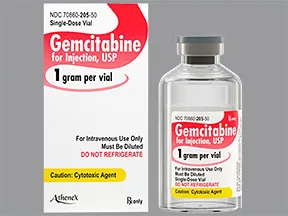 | |
| gemcitabine intravenous - | 200 mg vial |  | |
| gemcitabine intravenous - | 200 mg/5.26 mL (38 mg/mL) vial | 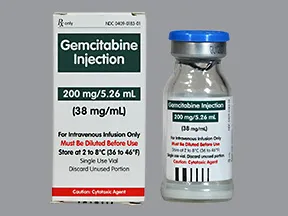 | |
| gemcitabine intravenous - | 1 gram vial | 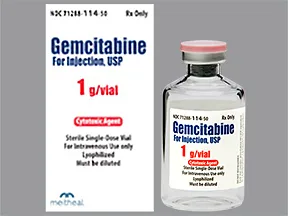 | |
| gemcitabine intravenous - | 200 mg vial | 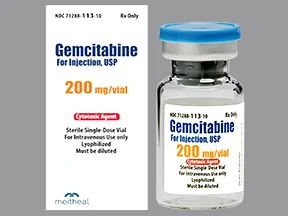 | |
| gemcitabine intravenous - | 1 gram vial |  | |
| gemcitabine intravenous - | 1 gram vial | 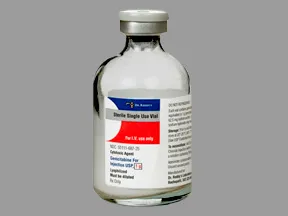 | |
| gemcitabine intravenous - | 100 mg/mL vial | 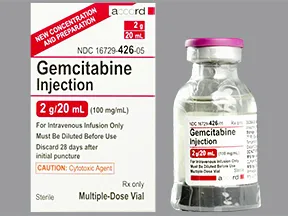 | |
| gemcitabine intravenous - | 100 mg/mL vial | 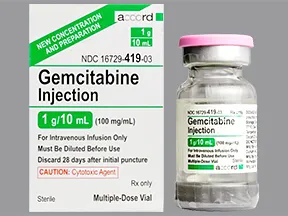 | |
| gemcitabine intravenous - | 200 mg vial |  | |
| gemcitabine intravenous - | 100 mg/mL vial | 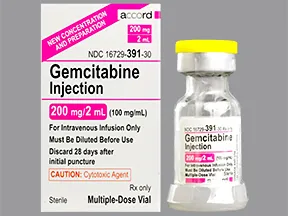 | |
| gemcitabine intravenous - | 100 mg/mL vial | 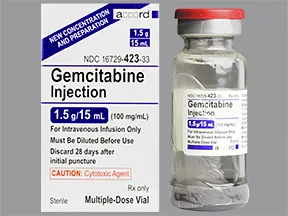 | |
| gemcitabine intravenous - | 2 gram/52.6 mL (38 mg/mL) vial | 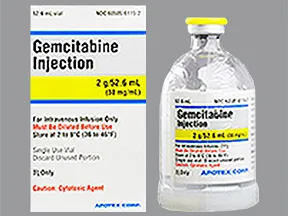 | |
| gemcitabine intravenous - | 1 gram/26.3 mL (38 mg/mL) vial | 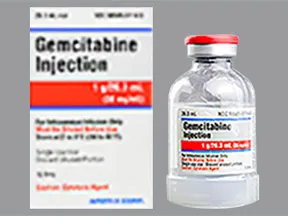 | |
| gemcitabine intravenous - | 200 mg/5.26 mL (38 mg/mL) vial | 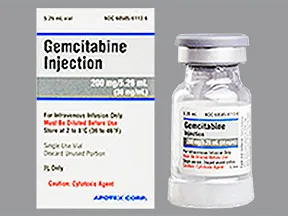 | |
| gemcitabine intravenous - | 2 gram vial | 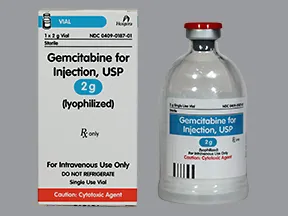 | |
| gemcitabine intravenous - | 1 gram vial |  | |
| gemcitabine intravenous - | 200 mg vial | 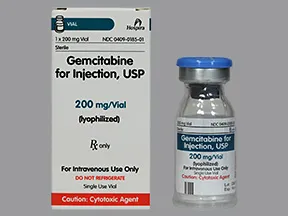 | |
| gemcitabine intravenous - | 2 gram/52.6 mL (38 mg/mL) vial | 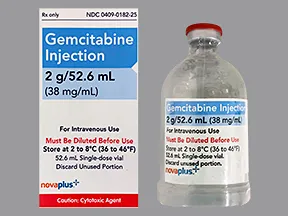 | |
| gemcitabine intravenous - | 2 gram/52.6 mL (38 mg/mL) vial | 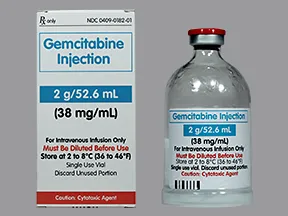 | |
| gemcitabine intravenous - | 1 gram/26.3 mL (38 mg/mL) vial | 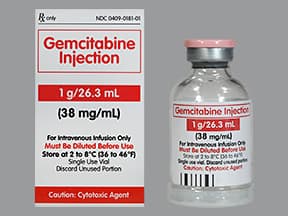 | |
| gemcitabine intravenous - | 1 gram vial |  | |
| gemcitabine intravenous - | 200 mg vial | 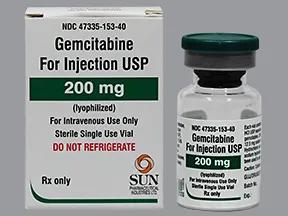 | |
| gemcitabine intravenous - | 200 mg vial | 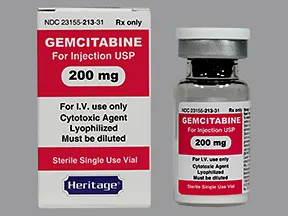 | |
| gemcitabine intravenous - | 2 gram/52.6 mL (38 mg/mL) vial | 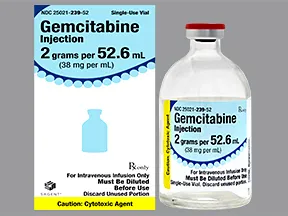 | |
| gemcitabine intravenous - | 1 gram/26.3 mL (38 mg/mL) vial |  | |
| gemcitabine intravenous - | 200 mg/5.26 mL (38 mg/mL) vial |  | |
| gemcitabine intravenous - | 1 gram vial |  | |
| gemcitabine intravenous - | 200 mg vial |  | |
| gemcitabine intravenous - | 200 mg vial | 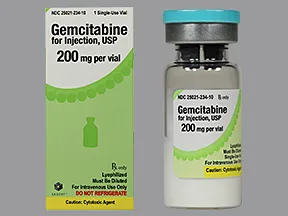 | |
| gemcitabine intravenous - | 1 gram vial | 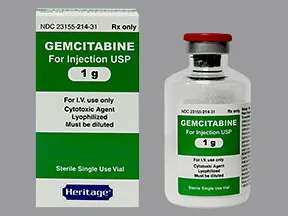 |
Copyright © 2010 First DataBank, Inc.
Patient Handout
gemcitabine intravenous
GEMCITABINE - INJECTION
(jem-SYE-ta-been)
COMMON BRAND NAME(S): Gemzar
USES: Gemcitabine is used to treat certain types of cancer (including biliary tract, breast, lung, ovarian, pancreatic). It is a chemotherapy drug that works by slowing or stopping the growth of cancer cells.
HOW TO USE: This medication is given by injection into a vein by a healthcare professional. It is given over 30 minutes as directed by your doctor. The dosage is based on your medical condition, body size, and response to treatment.
SIDE EFFECTS: Nausea, vomiting, diarrhea, mouth sores, drowsiness, muscle aches, and pain/redness/swelling at the injection site may occur. If any of these effects last or get worse, tell your doctor or pharmacist promptly.Temporary hair loss may occur. Normal hair growth should return after treatment has ended.People using this medication may have serious side effects. However, you have been prescribed this drug because your doctor has judged that the benefit to you is greater than the risk of side effects. Careful monitoring by your doctor may decrease your risk.Tell your doctor right away if you have any serious side effects, including: signs of lung problems (such as shortness of breath, cough), dizziness/lightheadedness, fainting, swelling ankles/feet/hands, numb/tingling skin, fast/slow/irregular heartbeat, signs of kidney problems (such as change in the amount of urine, bloody urine), signs of liver disease (such as yellowing eyes/skin, dark urine, stomach/abdominal pain).Get medical help right away if you have any very serious side effects, including: chest/jaw/left arm pain, severe headache, trouble speaking, weakness on one side of the body, vision changes, mental/mood changes (such as confusion), seizures.This medication may decrease bone marrow function, an effect that may lead to a low number of blood cells such as red cells, white cells, and platelets. This effect can cause anemia, decrease your body's ability to fight an infection, or cause easy bruising/bleeding. Get medical help right away if you develop any of the following symptoms: unusual tiredness, pale skin, signs of infection (such as sore throat that doesn't go away, fever, swollen lymph nodes, chills), easy bruising/bleeding.A very serious allergic reaction to this drug is rare. However, get medical help right away if you notice any symptoms of a serious allergic reaction, including: rash, itching/swelling (especially of the face/tongue/throat), severe dizziness, trouble breathing.This is not a complete list of possible side effects. If you notice other effects not listed above, contact your doctor or pharmacist.In the US -Call your doctor for medical advice about side effects. You may report side effects to FDA at 1-800-FDA-1088 or at www.fda.gov/medwatch.In Canada - Call your doctor for medical advice about side effects. You may report side effects to Health Canada at 1-866-234-2345.
PRECAUTIONS: Before using gemcitabine, tell your doctor or pharmacist if you are allergic to it; or if you have any other allergies. This product may contain inactive ingredients, which can cause allergic reactions or other problems. Talk to your pharmacist for more details.Before using this medication, tell your doctor or pharmacist your medical history, especially of: liver disease, kidney disease, radiation treatment, heart problems (such as irregular heartbeat, heart failure).This drug may make you drowsy. Alcohol or marijuana (cannabis) can make you more drowsy. Do not drive, use machinery, or do anything that needs alertness until you can do it safely. Limit alcoholic beverages. Talk to your doctor if you are using marijuana (cannabis).Before having surgery, tell your doctor or dentist about all the products you use (including prescription drugs, nonprescription drugs, and herbal products).Gemcitabine can make you more likely to get infections or may make current infections worse. Stay away from anyone who has an infection that may easily spread (such as chickenpox, COVID-19, measles, flu). Talk to your doctor if you have been exposed to an infection or for more details.Tell your health care professional that you are using gemcitabine before having any immunizations/vaccinations. Avoid contact with people who have recently received live vaccines (such as flu vaccine inhaled through the nose).To lower the chance of getting cut, bruised, or injured, use caution with sharp objects like razors and nail cutters, and avoid activities such as contact sports.Older female adults are more sensitive to the side effects of this medication, especially the risk of infection and easy bruising/bleeding.Tell your doctor if you are pregnant or plan to become pregnant. You should not become pregnant while using gemcitabine. Gemcitabine may harm an unborn baby. Your doctor should order a pregnancy test before you start this medication. Women using this medication should ask about reliable forms of birth control during treatment and for 6 months after the last dose. Men using this medication should ask about reliable forms of birth control during treatment and for 3 months after the last dose. If you or your partner becomes pregnant, talk to your doctor right away about the risks and benefits of this medication.It is unknown if this medication passes into breast milk. Because of the possible risk to the infant, breastfeeding is not recommended while using this medication and for 1 week after the last dose. Consult your doctor before breastfeeding.
DRUG INTERACTIONS: Drug interactions may change how your medications work or increase your risk for serious side effects. This document does not contain all possible drug interactions. Keep a list of all the products you use (including prescription/nonprescription drugs and herbal products) and share it with your doctor and pharmacist. Do not start, stop, or change the dosage of any medicines without your doctor's approval.
OVERDOSE: If someone has overdosed and has serious symptoms such as passing out or trouble breathing, call 911. Otherwise, call a poison control center right away. US residents can call 1-800-222-1222. Canada residents can call 1-844-764-7669.
NOTES: Lab and/or medical tests (such as complete blood count, liver/kidney function, blood pressure) should be done while you are using this medication. Keep all medical and lab appointments. Consult your doctor for more details.
MISSED DOSE: It is important to get each dose of this medication as scheduled. If you miss a dose, ask your doctor or pharmacist right away for a new dosing schedule.
STORAGE: Not applicable. This medication is given in a clinic and will not be stored at home.
MEDICAL ALERT: Your condition can cause complications in a medical emergency. For information about enrolling in MedicAlert, call 1-888-633-4298 (US) or 1-800-668-1507 (Canada).
Information last revised June 2024. Copyright(c) 2024 First Databank, Inc.
IMPORTANT: HOW TO USE THIS INFORMATION: This is a summary and does NOT have all possible information about this product. This information does not assure that this product is safe, effective, or appropriate for you. This information is not individual medical advice and does not substitute for the advice of your health care professional. Always ask your health care professional for complete information about this product and your specific health needs.
Formulary
Adding plans allows you to compare formulary status to other drugs in the same class.
To view formulary information first create a list of plans. Your list will be saved and can be edited at any time.
Adding plans allows you to:
- View the formulary and any restrictions for each plan.
- Manage and view all your plans together – even plans in different states.
- Compare formulary status to other drugs in the same class.
- Access your plan list on any device – mobile or desktop.




